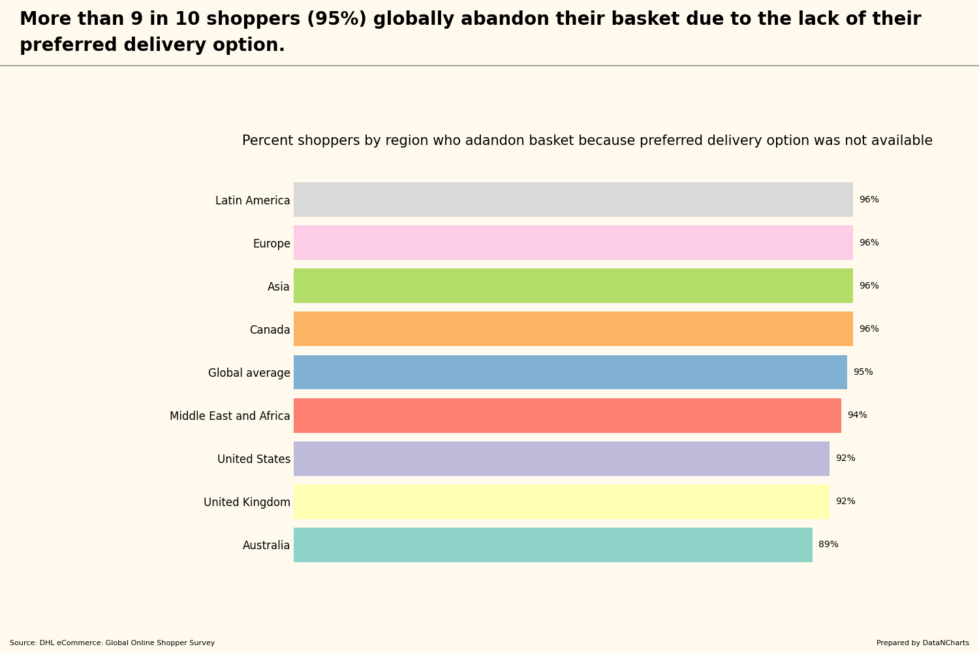Data Highlights
Nearly all regions report high basket abandonment due to unavailable delivery options.
Over 9 in 10 shoppers globally (95%) abandon their basket for this reason.
Asia, Canada, Europe, and Latin America show the highest abandonment rates at 96%.
Australia has the lowest abandonment rate, with 89% of shoppers affected.
The United States and the United Kingdom each see 92% of shoppers leaving their baskets.
Middle East and Africa report 94% abandonment due to delivery option issues.
Scope
In today’s fast-paced e-commerce landscape, the shopping experience must be seamless from start to finish. One critical area where many businesses struggle is with delivery options. When shoppers don’t see their preferred delivery method, they often abandon their carts. In this brief, we’ll explore how often this happens across different regions and what this means for e-commerce, retailers, and consumer brands.
The Global Picture: Widespread Cart Abandonment
Globally, over 9 in 10 shoppers (95%) abandon their baskets when they can’t find their preferred delivery option. This is a significant challenge for e-commerce businesses, as it shows that delivery preferences are a key driver of the purchase decision. Shoppers want flexibility and control over how they receive their purchases.
Although the global figure is high, this problem varies across regions. Let’s explore some of these differences.
The Highest Abandonment Rates: Four Regions at 96%
Asia, Canada, Europe, and Latin America have the highest rates of cart abandonment due to delivery issues, all at 96%. In these regions, nearly every shopper expects a variety of delivery options and leaves if they don’t get it.
This shows the urgency for businesses in these areas to offer more delivery choices. But this isn’t just a problem in these regions. Next, we’ll look at how other areas are impacted.
The U.S. and U.K.: Slightly Lower but Still High
In the United States and the United Kingdom, 92% of shoppers abandon their baskets when their preferred delivery method isn’t available. While this figure is slightly lower than in other regions, it still reflects a major problem for e-commerce businesses.
These countries often lead in retail innovation, but even here, delivery remains a dealbreaker. Let’s see how this compares to other regions, where the impact is also significant.
The Middle East and Africa: Close to the Global Average
The Middle East and Africa follow closely behind with 94% of shoppers abandoning their carts. This figure is close to the global average, showing that the challenge of providing delivery options is universal.
As we move to Australia, we’ll see how the abandonment rates there compare to other regions.
Australia: The Lowest Rate, Yet Still Significant
Australia has the lowest cart abandonment rate at 89%. Even though it’s slightly below the global average, it’s still a major factor that drives customers away. For businesses in Australia, this means there’s still work to be done.
Now, let’s explore what these findings mean for businesses moving forward.
Insights and Opportunities
This data shows that businesses across all regions need to take delivery preferences seriously. When nearly all shoppers expect their preferred delivery option, companies can’t afford to ignore this.
- Offer a variety of delivery options. Customers want control over their orders, whether that’s same-day, next-day, or click-and-collect services.
- Communicate clear shipping policies. Make delivery options and timelines easy to understand upfront.
How can businesses create content that resonates?
- Use ads and content that showcase flexible delivery options. Highlight convenience and fast shipping to meet customer needs.
- Tailor messages to specific regions. For areas like Asia or Latin America, emphasize the diversity of delivery options.
How can businesses guide customers toward a purchase?
- Make the preferred delivery option easy to find at checkout. Don’t bury it in small print.
- Offer incentives like free or discounted shipping for preferred methods to encourage customers to complete their purchase.
In today’s market, flexible and transparent delivery options aren’t just a perk—they’re a necessity for retaining customers and driving sales.
